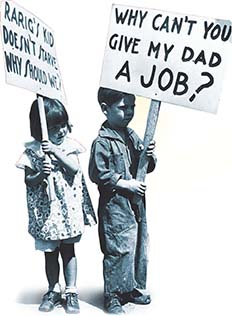SECTION 2: The Second New Deal

Children picket for the Workers’ Alliance during the Great Depression. ►
WITNESS HISTORY  AUDIO
AUDIO
Trying to Survive
During the Great Depression, people found themselves desperate for work. Daily visits to the unemployment office and workplaces often turned up nothing. Some of the jobless lost their homes. Others could not feed their children. One 12-year-old boy wrote to President Roosevelt to ask for help for his family.
“My father hasn’t worked for 5 months…. Please you do something…. We haven’t paid the gas bill, and the electric bill, haven’t paid grocery bill…. I have a sister she’s twenty years, she can’t find work. My father he staying home. All the time he’s crying because he can’t find work.”
—Anonymous 12-year-old boy, Chicago, 1936
Objectives
- Discuss the programs of social and economic reform in the second New Deal.
- Explain how New Deal legislation affected the growth of organized labor.
- Describe the impact of Roosevelt’s courtpacking plan on the course of the New Deal.
Terms and People
- Second New Deal
- WPA
- John Maynard Keynes
- pump priming
- Social Security Act
- Wagner Act
- collective bargaining
- Fair Labor Standards Act
- CIO
- sit-down strikes
- court packing
NoteTaking
Reading Skill: Connect Ideas Complete a table like the one below to record problems and the second New Deal’s solutions.
| Problem | Solution |
|---|---|
| Unemployment | |
Why It Matters FDR’s goals for the first New Deal were relief, recovery, and reform. Progress had been made, but there was still much work that needed to be done. Beginning in early 1935, Roosevelt launched an aggressive campaign to find solutions to the ongoing problems caused by the Great Depression. This campaign, known as the Second New Deal, created Social Security and other programs that continue to have a profound impact on the everyday lives of Americans. Section Focus Question: What major issues did the Second New Deal address?
Extending Social and Economic Reform
In his fireside chats, press conferences, and major addresses, Roosevelt explained the challenges facing the nation. He said that the complexities of the modern world compelled the federal government to “promote the general welfare” and to intervene to protect citizens’ rights. Roosevelt used legislation passed during the Second New Deal to accomplish these goals. The Second New Deal addressed the problems of the elderly, the poor, and the unemployed; created new public-works projects; helped farmers; and enacted measures to protect workers’ rights. It was during this period that the first serious challenges to the New Deal emerged.
New Programs Provide Jobs
In the spring of 1935, Congress appropriated $5 billion for new jobs and created the Works Progress Administration (WPA) to administer the program. Roosevelt placed his longtime associate Harry Hopkins in charge. The WPA built or improved a good part of the nation’s highways, dredged rivers and




